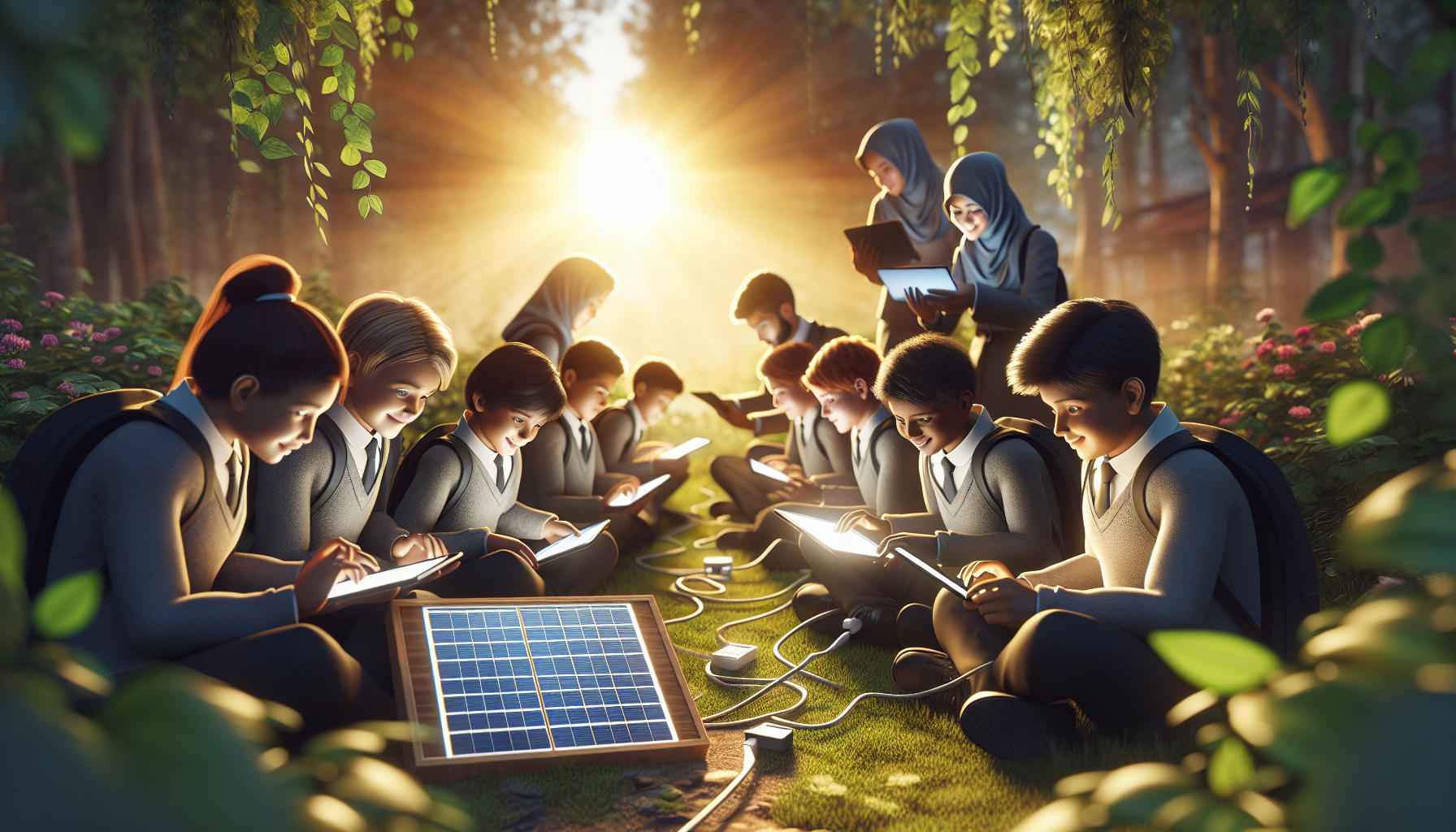In a world where the sun generously bestows its light upon us every day, harnessing its power for education seems not only logical but revolutionary. Imagine a future where every child, regardless of geographical barriers or economic constraints, has access to the infinite resources of learning. This is not a distant dream, but a rapidly approaching reality, thanks to solar-powered learning kits. These innovative tools are not just about lighting up classrooms; they’re about illuminating minds and empowering students with knowledge that knows no bounds. By integrating renewable energy with educational technology, we are paving the way for brighter futures for millions around the globe. 🌞
Education is the cornerstone of development, the key to unlocking potential and sparking creativity. Yet, in many parts of the world, students still face significant obstacles, from inadequate infrastructure to the lack of reliable electricity. Here, the brilliance of solar-powered learning kits comes into play. These kits, which include solar panels, rechargeable batteries, and educational devices, are designed to operate efficiently in environments with limited power access. This not only ensures continuity in learning but also introduces students to sustainable practices early on, instilling an understanding of and appreciation for renewable energy. The impact of such tools is transformative, fostering an environment where education can thrive despite external challenges.
As we delve deeper into the subject, this article will explore several critical aspects of solar-powered learning kits. First, we will examine the technology behind these kits, understanding how they are designed to withstand different environmental conditions and serve diverse educational needs. Following that, we’ll explore inspiring stories from communities that have embraced these tools, showcasing real-life examples of how solar-powered education is changing lives. We will also look at the broader implications for the environment and global educational standards, analyzing how these kits contribute to sustainable development goals and provide a model for future educational innovations. 📚
Finally, we will discuss the challenges and opportunities that lie ahead. Implementing solar-powered learning kits on a large scale requires collaboration between governments, NGOs, and private sectors, and we’ll consider what strategies can best support this endeavor. Additionally, we will address potential hurdles, such as maintenance and the need for teacher training, to ensure that these tools are effectively integrated into educational systems. By the end of this article, it will be clear that solar-powered learning kits are more than just a technological innovation; they are a beacon of hope for equitable education, providing a sustainable path forward in our quest for knowledge and progress. Join us on this enlightening journey as we explore how the power of the sun can truly empower education and ignite the potential within every learner. 🌍
Introduction to Solar-Powered Learning Kits
The integration of solar energy into education is not just a modern trend but a necessary shift towards sustainability and accessibility. Solar-powered learning kits represent a significant leap in this direction, providing innovative tools that enable education in off-grid and under-resourced areas. As we explore these kits, it’s essential to understand how they are revolutionizing learning environments and paving the way for brighter futures.
Solar energy, with its vast potential and renewable nature, has been increasingly harnessed in various fields. In the education sector, it provides a unique opportunity to tackle some of the most pressing challenges, such as the lack of electricity in rural and remote areas. By using solar-powered devices, students and educators in these regions gain access to essential resources that were previously unavailable or unreliable.
These learning kits typically include solar panels, energy storage solutions, and educational devices such as tablets and computers preloaded with educational software. This setup ensures that learning can continue irrespective of local electricity constraints. The following sections delve into the specifics of these kits, their components, benefits, and how they are being implemented worldwide.
Components of Solar-Powered Learning Kits
To fully appreciate the impact of solar-powered learning kits, one must first understand their key components. These kits are meticulously designed to ensure durability, ease of use, and efficacy in diverse environments.
Solar Panels and Energy Storage
At the heart of these learning kits are solar panels, which convert sunlight into electricity. These panels are often compact and portable, allowing them to be easily set up in various locations. They are designed to be efficient and effective, even in regions with lower sunlight availability. The energy generated is stored in batteries, ensuring a consistent power supply for educational activities throughout the day and night.
The table below provides a comparative overview of different types of solar panels used in learning kits:
| Type of Solar Panel | Efficiency | Durability | Cost |
|---|---|---|---|
| Monocrystalline | High | Long-lasting | Expensive |
| Polycrystalline | Moderate | Durable | Moderate |
| Thin-Film | Low | Flexible | Low |
Educational Devices
The educational devices included in these kits are specifically tailored to maximize learning. They often consist of tablets and laptops that are robust, energy-efficient, and preloaded with curriculum-aligned educational content. This content is curated to support a wide range of subjects and skill levels, ensuring inclusivity and adaptability to various educational needs.
Moreover, these devices are equipped with features that support interactive learning, such as touchscreens, built-in cameras, and audio capabilities. This fosters an engaging learning environment where students can interact with digital content in a hands-on manner.
Supporting Materials
Besides the core components, solar-powered learning kits may also include supplementary materials such as manuals, project-based learning guides, and additional educational resources. These materials are designed to enhance the learning experience, offering teachers and students tools for both structured and exploratory learning.
Benefits of Solar-Powered Learning Kits
The adoption of solar-powered learning kits brings a multitude of benefits that extend beyond educational outcomes, impacting communities and societies at large. By enabling access to quality education, these kits empower individuals and foster development in otherwise marginalized areas.
Accessibility and Inclusivity
One of the most significant advantages of solar-powered learning kits is their ability to reach remote and underserved communities. In areas where traditional infrastructure is lacking or unreliable, these kits provide a reliable and sustainable solution. By eliminating the dependency on grid electricity, they ensure that students have access to uninterrupted learning resources.
This inclusivity bridges the educational divide between urban and rural areas, offering all students the chance to pursue knowledge and skills necessary for their future. Furthermore, the flexibility of these kits allows them to be adapted for different educational settings, from formal classrooms to community learning centers.
Environmental and Economic Impact
Harnessing solar energy for educational purposes also has significant environmental benefits. By relying on renewable energy sources, these kits contribute to reducing carbon emissions and minimizing ecological footprints. This aligns with global efforts to combat climate change and promotes environmental awareness among young learners.
Economically, the use of solar-powered kits can lead to cost savings for schools and educational institutions. By decreasing dependency on traditional power sources, they reduce operational costs associated with electricity. Additionally, the use of durable and long-lasting materials ensures that these kits have a low maintenance cost, providing a sustainable solution for the long term.
Empowering Educators and Communities
The implementation of solar-powered learning kits not only benefits students but also empowers educators. Teachers gain access to a wealth of digital resources that can enhance their teaching methods and improve learning outcomes. With these tools, educators can offer more personalized and engaging lessons that cater to diverse learning styles.
Communities, too, reap the benefits as these kits often serve as catalysts for broader development initiatives. They provide opportunities for community members to engage in educational activities and gain skills that are transferable to various aspects of life and work. This can lead to increased employment opportunities, improved literacy rates, and overall community well-being.
Case Studies and Global Implementation
The success of solar-powered learning kits can be seen in various case studies and projects implemented across the globe. These initiatives highlight the transformative power of combining education with renewable energy solutions.
Africa: Bridging the Educational Divide
In many African countries, access to education is hindered by a lack of reliable electricity. Solar-powered learning kits have been instrumental in overcoming this barrier, enabling students in remote villages to participate in digital learning. Projects in countries like Kenya and Tanzania have demonstrated significant improvements in literacy and numeracy skills, empowering students to pursue further education and career opportunities.
For example, in Kenya, a project implemented in rural schools provided solar-powered tablets to students, allowing them to access interactive lessons and educational games. This not only improved academic performance but also increased student engagement and attendance.
Asia: Innovating Education with Technology
In parts of Asia, solar-powered learning kits have been used to introduce technology into traditional educational settings. In India, for instance, these kits have facilitated the integration of digital literacy into school curricula, equipping students with skills that are crucial in today’s digital economy.
The use of solar energy has also made it possible to extend learning opportunities beyond the classroom. Community centers equipped with solar-powered kits have become hubs of learning and innovation, providing resources for both students and adults.
Latin America: Supporting Sustainable Development
In Latin America, solar-powered learning kits are playing a pivotal role in supporting sustainable development goals. In countries like Brazil and Mexico, these kits have been used to promote environmental education and awareness. By incorporating lessons on sustainability and renewable energy, students are encouraged to become advocates for environmental stewardship in their communities.
These projects also highlight the importance of community involvement, as local stakeholders are often engaged in the implementation and maintenance of these kits. This fosters a sense of ownership and accountability, ensuring the sustainability and success of the initiatives.
Challenges and Future Directions
Despite the numerous benefits and successful implementations, solar-powered learning kits face several challenges that need to be addressed to maximize their impact. Understanding these challenges is crucial for developing effective strategies and ensuring the sustainability of these educational solutions.
Technical and Logistical Challenges
One of the primary challenges associated with solar-powered learning kits is the technical expertise required for their installation and maintenance. Ensuring that local communities have the necessary skills and knowledge to manage these systems is essential for their long-term success. This often requires training and capacity-building initiatives to empower local stakeholders.
Logistical challenges also arise in the distribution and deployment of these kits, especially in remote areas with limited infrastructure. Efficient supply chain management and strategic partnerships are crucial to overcoming these hurdles and ensuring that kits reach their intended destinations.
Funding and Resource Allocation
Securing adequate funding for the development and distribution of solar-powered learning kits remains a significant challenge. While there is growing interest from governments, NGOs, and private sector partners, sustainable funding models are needed to support large-scale implementation and maintenance.
Resource allocation is also critical, as it involves balancing the costs of solar technology with other educational priorities. Strategic planning and collaboration among stakeholders are necessary to ensure that resources are used effectively and equitably.
Future Directions and Innovations
Looking ahead, there is immense potential for innovation in the field of solar-powered learning kits. Advancements in solar technology, such as increased efficiency and reduced costs, will likely enhance the accessibility and affordability of these solutions. Additionally, integrating emerging technologies like artificial intelligence and virtual reality could further enrich the learning experience.
Collaborative efforts among governments, educational institutions, and private sector partners will be essential in driving these innovations and scaling their impact. By continuing to invest in research and development, we can ensure that solar-powered learning kits remain at the forefront of educational transformation.
For a deeper understanding of how solar-powered learning kits are transforming education, check out this informative video: How Solar-Powered Education is Lighting Up the Future – Solar Schools Channel.
- Explore how solar-powered kits are being used in different countries.
- Understand the challenges and opportunities in implementing these solutions.
- Learn about the benefits of integrating renewable energy in education.
🌟 Empower your education today with innovative solar-powered solutions!

Conclusion
In conclusion, the integration of solar-powered learning kits into educational environments represents a pivotal shift towards sustainable and inclusive education. Throughout this article, we have explored the multifaceted benefits and transformative potential of these innovative tools. By harnessing the power of the sun, these kits not only provide a reliable energy source for educational technology but also promote environmental awareness among students. They are designed to bridge the educational divide, particularly in remote and underserved regions, by ensuring that learning can continue unhindered by power shortages or lack of resources.
We’ve highlighted how solar-powered kits can support a wide array of learning activities, from powering digital devices and internet connectivity to facilitating hands-on experiments that demystify the principles of renewable energy. These kits are more than just technical tools; they are gateways to knowledge, fostering curiosity, critical thinking, and problem-solving skills among learners.
The importance of embracing such sustainable educational solutions cannot be overstated. As climate change continues to pose significant challenges globally, education systems must adapt by incorporating green technologies that reduce carbon footprints and educate the next generation on sustainable practices. By doing so, we are not only empowering students with knowledge but also preparing them to be conscientious global citizens who can contribute positively to the environment and society.
Moreover, the ripple effect of implementing solar-powered learning kits extends beyond the classroom. Communities can benefit from the reduced energy costs and increased accessibility to education, paving the way for economic growth and improved quality of life. Teachers, parents, and policymakers play crucial roles in this transition, advocating for and supporting the adoption of solar technology in schools and educational programs.
We encourage readers to engage with this exciting movement towards greener education. Whether you are an educator, a student, a parent, or a policy advocate, there are numerous ways to get involved. Consider initiating or supporting projects that introduce solar-powered learning kits to local schools or educational initiatives. Share this article with colleagues and friends to spread awareness of the benefits and potential of solar-powered education. Engage in discussions about the future of education and the environment, and explore opportunities to contribute to this change.
By investing in solar-powered learning kits, we are investing in a brighter, more sustainable future for education and the planet. Let us work together to ensure that every child has access to the tools and resources they need to succeed, regardless of their geographical location or economic background.
For more information on solar-powered educational initiatives and to explore how you can contribute, please visit Solar Foundation and Solar Energy International. These organizations are at the forefront of promoting solar energy solutions and offer a wealth of resources and opportunities for those interested in renewable energy education.
Together, we can transform education and empower the next generation with the tools and knowledge they need to build a sustainable future. Let’s embrace the potential of solar power to illuminate the path to brighter, more equitable learning experiences for all 🌞📚.
Toni Santos is a visual storyteller and educational ethnographer whose work celebrates the fluid knowledge systems of nomadic cultures. Through art and research, Toni brings attention to how learning has thrived outside traditional institutions—rooted in movement, oral tradition, and deep connection to land and community.
Guided by a passion for ancestral wisdom, adaptive pedagogy, and cultural resilience, Toni explores the tools, rituals, and environments that once shaped the minds of travelers, herders, and migrating communities. Whether illustrating storytelling circles beneath open skies, wearable mnemonic devices, or maps woven into textiles, Toni’s work honors learning as a lived, sensory, and communal experience.
With a background in visual anthropology and intercultural design, Toni reconstructs the educational models of mobile societies through images and narratives that restore their dignity and relevance in today’s world.
As the creative mind behind Vizovex, Toni shares a rich tapestry of visual essays, artifact-inspired art, and curated stories that reveal the genius of teaching and learning on the move.
His work is a tribute to:
The wisdom of learning through journey, rhythm, and story
The spatial and environmental intelligence of nomadic cultures
The power of intergenerational knowledge passed outside walls
Whether you’re an educator, researcher, or lifelong learner, Toni invites you to step into a world where education is not confined, but carried—one step, one song, one shared insight at a time.





